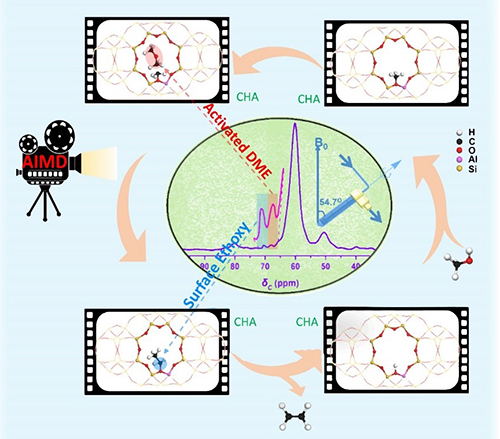Study Reveals Formation Mechanism of First Carbon-carbon Bond in Methanol-to-Olefins Process
A joint research team led by Prof. LIU Zhongmin, Prof. WEI Yingxu, and Prof. XU Shutao from the Dalian Institute of Chemical Physics (DICP) of the Chinese Academy of Sciences (CAS) revealed the mechanism underlying the formation of the first carbon-carbon (C-C) bond formation during the methanol-to-olefins (MTO) process.
This study was published in Chem on June 23.
Prof. ZHENG Anmin's group from Innovation Academy for Precision Measurement Science and Technology of CAS was also involved in the study.
The first C-C bond in the MTO process is formed at the initial stage of the reaction. There is no direct method to elucidate the bond formation/reaction mechanism due to the difficulty in capturing intermediate species.

Revealing the whole first C-C bond formation processes in MTO reaction: based on the in situ NMR spectroscopic evidences and advanced ab initio molecular dynamics (AIMD) theoretical calculation method (Image by XU Shutao and WEI Yingxu)
"We investigated the direct C-C bond formation mechanism during the initial MTO reaction over HSSZ-13 zeolite with an 8-membered ring and a chabazite topological structure," said Prof. XU.
They detected the evolution of the organic species on the SSZ-13 catalyst surface during the methanol conversion. For the first time, they directly captured the surface ethoxy species (SES), the critical species containing the initial C-C bond under real MTO reaction conditions at the initial reaction stage.
Moreover, the researchers employed the ab initio molecular dynamics (AIMD) theoretical calculation simulation to predict and present the visualized and complete process of initial C-C bond formation starting from the C1 reactants and C1 intermediates.
Based on the experimental and theoretical evidence, they established the complete and feasible initial C-C bond formation routes, namely, surface methoxy species (SMS)/trimethoxyonium (TMO) mediated methanol/dimethyl ether (DME) activation with a synergistic effect from SMS and the negatively charged framework oxygen atoms to form SES.
"Our study not only sheds light on the controversial issue of the first C-C bond formation in the MTO process, but also enriches the fundamental theory of C1 catalytic chemistry," said Prof. WEI.
This work was supported by the National Natural Science Foundation of China, Strategic Priority Research Program of the Chinese Academy of Sciences, iChEM, the Youth Innovation Promotion Association of the Chinese Academy of Sciences and Liaoning Revitalization Talents Program. (Text by XU Shutao and WEI Yingxu)